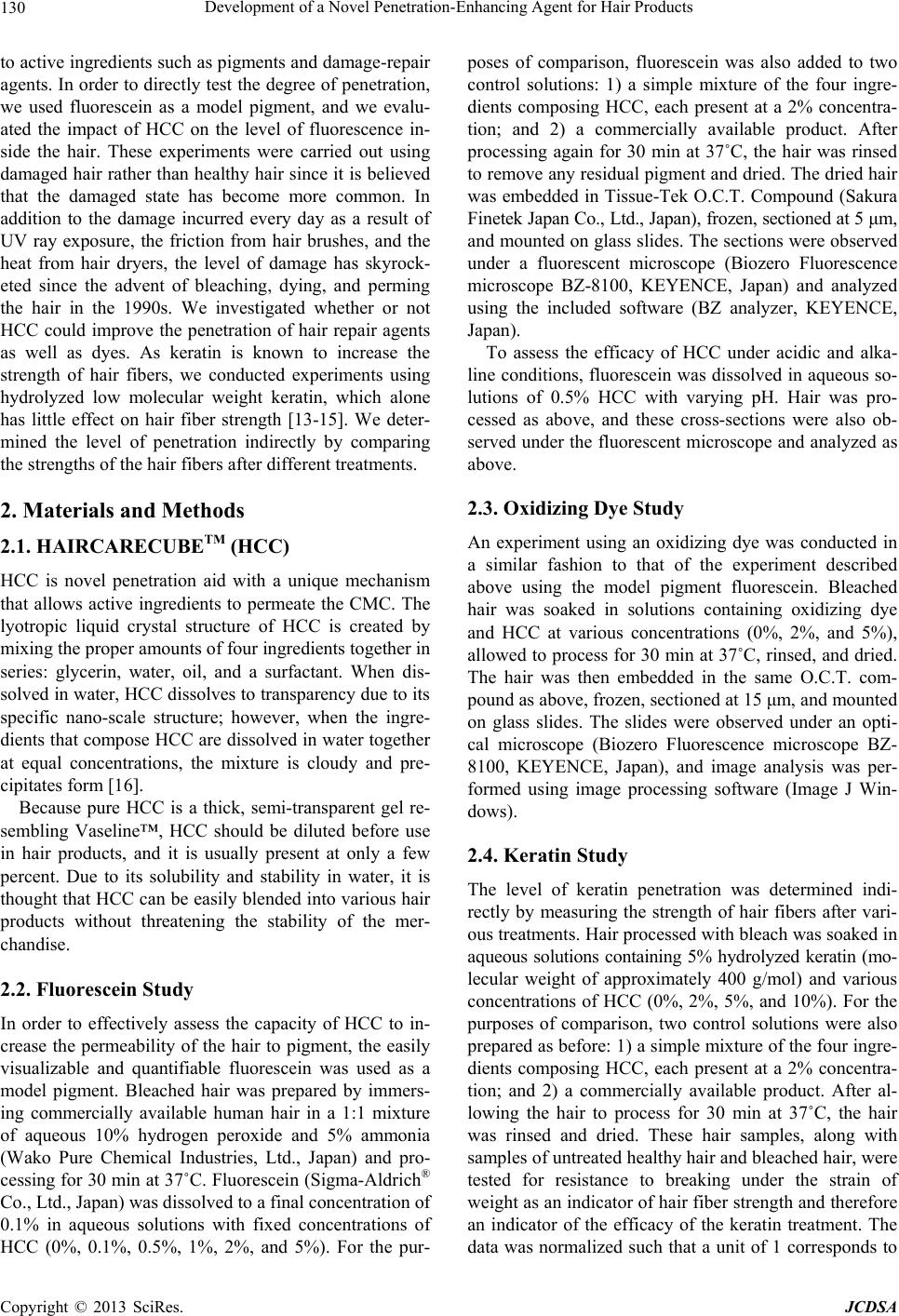
Development of a Novel Penetration-Enhancing Agent for Hair Products
130
to active ingredients such as pigments and damage-repair
agents. In order to directly test the degree of penetration,
we used fluorescein as a model pigment, and we evalu-
ated the impact of HCC on the level of fluorescence in-
side the hair. These experiments were carried out using
damaged hair rather than healthy hair since it is believed
that the damaged state has become more common. In
addition to the damage incurred every day as a result of
UV ray exposure, the friction from hair brushes, and the
heat from hair dryers, the level of damage has skyrock-
eted since the advent of bleaching, dying, and perming
the hair in the 1990s. We investigated whether or not
HCC could improve the penetration of hair repair agents
as well as dyes. As keratin is known to increase the
strength of hair fibers, we conducted experiments using
hydrolyzed low molecular weight keratin, which alone
has little effect on hair fiber strength [13-15]. We deter-
mined the level of penetration indirectly by comparing
the strengths of the hair fibers after different treatments.
2. Materials and Methods
2.1. HAIRCARECUBETM (HCC)
HCC is novel penetration aid with a unique mechanism
that allows active ingredients to permeate the CMC. The
lyotropic liquid crystal structure of HCC is created by
mixing the proper amounts of four ingredients together in
series: glycerin, water, oil, and a surfactant. When dis-
solved in water, HCC dissolves to transparency due to its
specific nano-scale structure; however, when the ingre-
dients that compose HCC are dissolved in water together
at equal concentrations, the mixture is cloudy and pre-
cipitates form [16].
Because pure HCC is a thick, semi-transparent gel re-
sembling Vaseline™, HCC should be diluted before use
in hair products, and it is usually present at only a few
percent. Due to its solubility and stability in water, it is
thought that HCC can be easily blended into various hair
products without threatening the stability of the mer-
chandise.
2.2. Fluorescein Study
In order to effectively assess the capacity of HCC to in-
crease the permeability of the hair to pigment, the easily
visualizable and quantifiable fluorescein was used as a
model pigment. Bleached hair was prepared by immers-
ing commercially available human hair in a 1:1 mixture
of aqueous 10% hydrogen peroxide and 5% ammonia
(Wako Pure Chemical Industries, Ltd., Japan) and pro-
cessing for 30 min at 37˚C. Fluorescein (Sigma-Aldrich®
Co., Ltd., Japan) was dissolved to a final concentration of
0.1% in aqueous solutions with fixed concentrations of
HCC (0%, 0.1%, 0.5%, 1%, 2%, and 5%). For the pur-
poses of comparison, fluorescein was also added to two
control solutions: 1) a simple mixture of the four ingre-
dients composing HCC, each present at a 2% concentra-
tion; and 2) a commercially available product. After
processing again for 30 min at 37˚C, the hair was rinsed
to remove any residual pigment and dried. The dried hair
was embedded in Tissue-Tek O.C.T. Compound (Sakura
Finetek Japan Co., Ltd., Japan), frozen, sectioned at 5 μm,
and mounted on glass slides. The sections were observed
under a fluorescent microscope (Biozero Fluorescence
microscope BZ-8100, KEYENCE, Japan) and analyzed
using the included software (BZ analyzer, KEYENCE,
Japan).
To assess the efficacy of HCC under acidic and alka-
line conditions, fluorescein was dissolved in aqueous so-
lutions of 0.5% HCC with varying pH. Hair was pro-
cessed as above, and these cross-sections were also ob-
served under the fluorescent microscope and analyzed as
above.
2.3. Oxidizing Dye Study
An experiment using an oxidizing dye was conducted in
a similar fashion to that of the experiment described
above using the model pigment fluorescein. Bleached
hair was soaked in solutions containing oxidizing dye
and HCC at various concentrations (0%, 2%, and 5%),
allowed to process for 30 min at 37˚C, rinsed, and dried.
The hair was then embedded in the same O.C.T. com-
pound as above, frozen, sectioned at 15 μm, and mounted
on glass slides. The slides were observed under an opti-
cal microscope (Biozero Fluorescence microscope BZ-
8100, KEYENCE, Japan), and image analysis was per-
formed using image processing software (Image J Win-
dows).
2.4. Keratin Study
The level of keratin penetration was determined indi-
rectly by measuring the strength of hair fibers after vari-
ous treatments. Hair processed with bleach was soaked in
aqueous solutions containing 5% hydrolyzed keratin (mo-
lecular weight of approximately 400 g/mol) and various
concentrations of HCC (0%, 2%, 5%, and 10%). For the
purposes of comparison, two control solutions were also
prepared as before: 1) a simple mixture of the four ingre-
dients composing HCC, each present at a 2% concentra-
tion; and 2) a commercially available product. After al-
lowing the hair to process for 30 min at 37˚C, the hair
was rinsed and dried. These hair samples, along with
samples of untreated healthy hair and bleached hair, were
tested for resistance to breaking under the strain of
weight as an indicator of hair fiber strength and therefore
an indicator of the efficacy of the keratin treatment. The
data was normalized such that a unit of 1 corresponds to
Copyright © 2013 SciRes. JCDSA